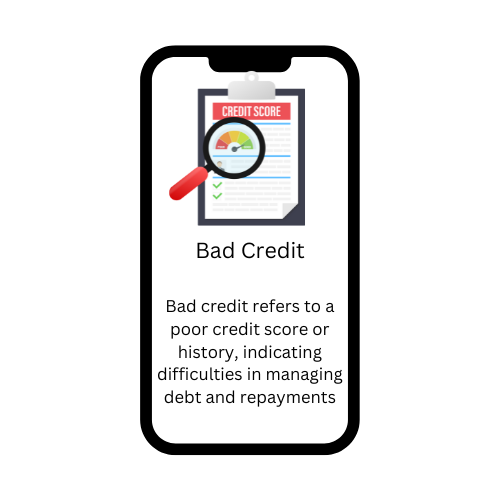Bad credit refers to a poor credit score or history, indicating difficulties in managing debt and repayments. It typically results from missed payments, loan defaults, high credit utilization, or bankruptcy. Individuals with bad credit are seen as high-risk borrowers, making it challenging to secure loans, credit cards, or mortgages.
If approved, they often face higher interest rates and stricter terms. Bad credit can also affect opportunities to rent property or even secure certain jobs. However, with responsible financial behaviour—timely payments, reducing debt, and monitoring credit reports—it is possible to improve a bad credit score over time.
Key Concepts:
Credit Score: A numerical value that represents a borrower’s creditworthiness. It is calculated based on credit history, repayment behaviour, outstanding debt, and other financial factors. Scores typically range from 300 to 900, with higher scores indicating better creditworthiness.
- Good Credit: 700 and above
- Fair Credit: 600–699
- Bad Credit: Below 600
Credit History: A record of a borrower’s past borrowing and repayment behavior. It includes details like missed payments, defaults, bankruptcies, and the amount of credit currently owed.
Credit Bureaus: Agencies that collect and maintain credit information, such as Equifax, Experian, and TransUnion. In India, CIBIL (Credit Information Bureau India Limited) is a major credit bureau.
Causes of Bad Credit:
- Missed or Late Payments: Failure to make credit card, loan, or mortgage payments on time.
- High Credit Utilization: Using too much of the available credit limit (e.g., maxing out credit cards).
- Defaults: Failing to repay a loan or settle credit card balances.
- Bankruptcy or Foreclosure: Legal processes that indicate an inability to pay outstanding debts.
- Too Many Loan Applications: Frequent applications for credit may signal financial instability and can negatively affect the score.
Impact of Bad Credit:
- Loan Rejections: Lenders may reject loan applications from individuals with bad credit, viewing them as high-risk borrowers.
- Higher Interest Rates: If a loan is approved, lenders may charge higher interest rates to compensate for the risk.
- Limited Credit Card Options: Those with bad credit may only qualify for secured credit cards or cards with higher fees and lower limits.
- Difficulty Renting or Leasing: Landlords and leasing companies may check credit scores before renting properties or vehicles.
- Employment Challenges: Some employers, particularly in financial sectors, may check credit reports as part of the hiring process.
How to Improve Bad Credit:
- Pay Bills on Time: Ensuring timely payments is one of the most effective ways to boost a credit score.
- Reduce Debt: Paying down outstanding balances can help lower the credit utilization ratio and improve creditworthiness.
- Avoid Applying for Too Much Credit: Limiting the number of new credit applications prevents multiple hard inquiries from affecting the score.
- Check Credit Reports Regularly: Reviewing credit reports for errors and disputing inaccuracies can also improve a credit score.
- Use Credit Wisely: Keeping balances low on credit cards and paying off full amounts monthly helps build positive credit history.
Bad Credit in the Indian Context:
In India, credit scores are mainly provided by CIBIL, and bad credit can affect an individual’s ability to access financial services. For instance:
- Loan Approvals: Banks and Non-Banking Financial Companies (NBFCs) in India use credit scores extensively in deciding whether to approve loans.
- Credit Card Limits: Bad credit may result in lower credit limits or even refusal of credit card applications.
Example of Bad Credit Situations in India:
- Default on Personal Loans: If an individual in India fails to repay a personal loan, their credit score will drop, making it harder to get another loan from any bank or NBFC.
- Non-Payment of Credit Card Bills: Missing credit card payments not only incurs fees but also lowers the score significantly.
Conclusion:
Bad credit can significantly restrict financial opportunities, but it is not irreversible. By adopting responsible financial habits, individuals can gradually improve their credit score and regain access to better financial products.






